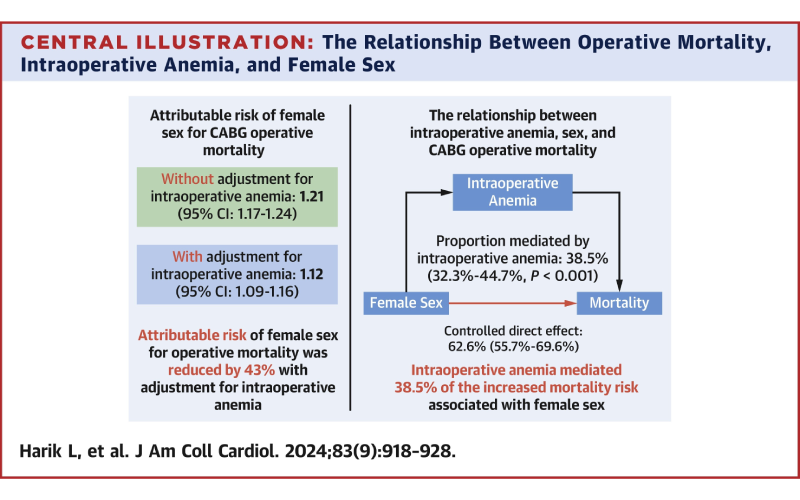For decades, doctors have known that women have worse outcomes than men after coronary artery bypass graft (CABG) surgery. Despite improvements, a vast disparity between the sexes persists and the reasons for it have remained unidentified.
Recognizing these gender disparities, Mario Gaudino, MD, PhD, a cardiothoracic surgeon at NewYork-Presbyterian and Weill Cornell Medicine, has been leading research looking at the risk factors affecting the health outcomes of women undergoing CABG. Intraoperative anemia has traditionally been considered a risk factor for operative mortality and adverse cardiac, renal, neurologic, and pulmonary outcomes after heart surgery in both women and men. However, until recently, anemia has not been explored as a potential explanation for poorer CABG mortality in women specifically.
Dr. Gaudino and his colleagues recently published the largest and most comprehensive study to date identifying intraoperative anemia as a mediator for a significant portion of the elevated CABG mortality risk in women. Below, he discusses findings from the study and how the issue can be addressed to improve outcomes in the future.
Research Goals
Intraoperative anemia during CABG surgery is related to hemodilution that results from the use of priming solutions for cardiopulmonary bypass, and the depletion of red blood cells. Anemia can result in inadequate oxygen delivery, reduced cellular oxygen, increased acidosis, and abnormal calcium balance — all of which may activate cell death pathways and promote tissue injury. Due to the combination of lower starting hematocrit and generally smaller body size, women are more susceptible to severe intraoperative hemodilution anemia. Through this study, we wanted to understand the influence of intraoperative anemia on sex-specific mortality after CABG surgery.
Research Methods
We conducted a cohort study of 1,434,225 isolated primary CABG patients (including 344,357 women) from the Society of Thoracic Surgeons Adult Cardiac Surgery Database (2011-2022), the largest cardiac surgery database in the United States.
Patients were excluded from the study if they required resuscitation before surgery, if they underwent emergent or salvage surgery, or if they underwent reoperative CABG. Our primary outcome was operative mortality. Causal mediation analysis derived the total effect of female sex on operative mortality risk and the proportion of that effect mediated by intraoperative anemia.
We hypothesized that the association of female sex with CABG operative mortality may be mediated by intraoperative anemia, and that in absence of severe intraoperative anemia, differences in CABG outcomes between the sexes might be largely mitigated. We examined hematocrit, patient demographics, medical history, and surgical data and performed sensitivity analyses to determine the effects of these factors on 30-day operative mortality.
Key Findings
This was the first nationwide study to examine gender disparity in CABG operative mortality as a function of intraoperative anemia. Our findings confirmed that women had higher operative mortality than men following CABG: 2.8% versus 1.7%. Specifically, women comprised 58.8% of the patients with life-threatening anemia (nadir intraoperative hematocrit below 19.5%) and 51.8% of the patients with a nadir intraoperative hematocrit below 22%.

The study’s findings showed that women were more likely to experience life-threatening intraoperative anemia.
After adjusting for possible confounding variables, we found that 38.5% of the increased risk of operative mortality could be attributed to more severe intraoperative anemia, particularly when hematocrit values fell below 22%.
Future Implications
While this study does not establish causation, it does demonstrate a distinct association between intraoperative anemia and female CABG mortality. We knew that anemia was a risk factor in general for cardiac surgery outcomes, but we were surprised that it explained nearly 40% of the excess CABG mortality in women. That was a striking finding.
Fortunately, intraoperative anemia is an actionable target to improve operative mortality in women after CABG and reduce the gender gap. There are a variety of interventions that may reduce intraoperative anemia, and they may have a larger effect in women than in men. Examples include the use of iron supplementation, or even erythropoietin. Additionally, using heart-lung bypass machines with shorter circuits would limit the volume of blood-diluting solution needed to run the pump. There have been more than 10 randomized clinical trials in the past looking at the effect of these smaller circuits, but none of them reported the outcomes by sex. We're trying to access the data from these studies so we can analyze the women separately. If there is a difference, we hope to design a randomized clinical trial in women testing these smaller circuits.
At NewYork-Presbyterian and Weill Cornell Medicine, we are addressing these research questions from different angles, including cardiac surgery, interventional cardiology, advanced cardiac imaging, and blood conservation strategies. Last year, we published an important study on this topic in JAMA Surgery and have launched the ROMA:Women study comparing single versus multiple arterial grafts for CABG in women. We are also launching RECHARGE (Revascularization CHoices Among underRepresented Groups Evaluation), a clinical trial comparing overall survival and quality of life for women and underrepresented minorities treated with coronary stents or CABG. This studies demonstrate the institution’s dedication to improving outcomes and investment in addressing cardiac surgery disparities.




